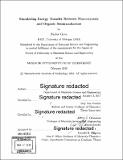Simulating energy transfer between nanocrystals and organic semiconductors
Author(s)
Geva, Nadav
DownloadFull printable version (10.68Mb)
Other Contributors
Massachusetts Institute of Technology. Department of Materials Science and Engineering.
Advisor
Troy Van Voorhis.
Terms of use
Metadata
Show full item recordAbstract
Recent trends in renewable energy made silicon based photovoltaics the undisputed leader. Therefore, technologies that enhance, instead of compete with, silicon based solar cells are desirable. One such technology is the use of organic semiconductors and noncrystalline semiconductors for photon up- and down-conversion. However, the understanding of energy transfer in these hybrid systems required to effectively engineer devices is missing. In this thesis, I explore and explain the mechanism of energy transfer between noncrystalline semiconductors and organic semiconductors. Using a combination of density functional calculations, molecular dynamics, and kinetic theory, I have explored the geometry, morphology, electronic structure, and coarse grained kinetics of these system. The result is improved understanding of the transfer mechanism, rate, and the device structure needed for efficient devices. I have also looked at machine learning inspired algorithm for acceleration of density functional theory methods. By training machine learning models on DFT data, a much improved initial guess can be made, greatly accelerating DFT optimizations. Generating and examining this data set also revealed a remarkable degree of structure, that perhaps can be further exploited in the future.
Description
Thesis: Ph. D., Massachusetts Institute of Technology, Department of Materials Science and Engineering, 2018. Cataloged from PDF version of thesis. Includes bibliographical references (pages 111-129).
Date issued
2018Department
Massachusetts Institute of Technology. Department of Materials Science and EngineeringPublisher
Massachusetts Institute of Technology
Keywords
Materials Science and Engineering.